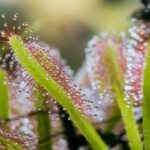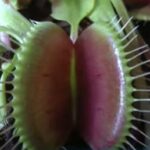As an Amazon Associate, this site earns commissions from qualifying purchases. For more details, click here.
Drosera burmannii is one of the most striking carnivorous plants you can grow. Caring for D. burmannii or Burmese Sundews is easier than you may think. Even if you are a beginner, this simple step by step guide will show you everything required for their cultivation.
Drosera burmannii grows best in moist soil, preferably 1:1 silica sand and peat. These sundews also need a minimum of 6-8 hours of light and the temperature should not be higher than 85 degrees F.
Drosera Burmannii Care Sheet
| Soil | 1:1 peat and silica sand, soil must be always moist |
| Water | Rainwater, distilled or purified |
| Light | 8-10+ hours natural light, indoor grow lights are fine |
| Food | Small insects, fish pellets, mealworms |
| Temperature | 71-81 F (24-27 C) |
| Humidity | 60% ideal |
| Dormancy | Not needed |
| Propagation | Seeds recommended |
Lighting Requirements
Drosera burmannii thrives in light, the more the better. You can use natural or artificial light, what is important is the plant gets as much of it as possible.
Its color changes depending on how much light is available. Lack of it turns the tentacles into a red or pinkish color. With enough lighting and food D. burmannii turns into a vivid green.
Its lighting requirements are similar to Drosera binata. If your D. burmannii is indoors, leave it on a south facing window. This allows the plant to soak plenty of natural light which is good.
if you prefer to use artificial lighting the photoperiod is 13-16 hours. A T8 fluorescent cool white light is a nice choice. It is good to have artificial lights in case natural light is limited or the sky is overcast. Another excellent option would be GooingTop Grow Light Strips as they are easy to set up and work very well with sundews.
Outdoor Burmese Sundews need little maintenance. Find the sunniest spot in your garden, but move the plant under partial shade if the temperature gets too hot. Sundews need as much as light as it can get, but too much heat should be avoided.
Temperature and Humidity
Drosera burmannii thrives in subtropical temperatures between 71-81 F (24-27 C). However, Burmese Sundews start to get affected when the temperature goes above 85 F (29 C). Low humidity is fine as long as air flow is limited or nonexistent.
While other sundews like D. aliciae can handle 85-90+F temperature, D. burmannii does not. It is true that if grown outdoors, some variants adapt to higher temperatures. But most of them prefer a subtropical climate.
For best results you should keep the temperature no higher than 85 F. If you can grow D. burmannii between 71-81 F that is even better.
While D. burmannii benefits from copious amounts of light, it does not handle heat well. Because these two often happen at the same time, you have to raise the humidity.
Burmese Sundews will be fine with low humidity. But a humidity rate of 60% or higher can lead to greater mucilage production. Mucilage is the dew-like stuff on its leaves and tentacles. Intense heat can dry the dew so high humidity can counter that.
Soil and Pot Requirements
Drosera burmannii can adapt to different types of media, but the best soil mixture is equal parts peat moss and silica sand. Long fibered sphagnum (LFS) is another good choice and is just as effective. The pot should be at least 3 inches.
Burmese Sundews grow in live sphagnum and there is no need to add anything else. You can throw in a bit of perlite or sand and it will not hurt. But those are unnecessary with LFS. With peat however you do need to add sand. 1:1 is the standard ratio though some growers find 2:1 works too.
An even simpler solution is to buy a ready to use soil mix like Perfect Plants Carnivorous Plant Soil. Just follow the instructions on the package and you are all set.
You can use just about any plant container as sundews are not particular. But it has to be at least 3 inches. Some Burmese Sundews grow fine in small pots but a taller, deeper pot ensures the roots have room to grow.
If your variant has long roots, a small pot could be disastrous. Better to go with a large container so the roots have space. This also saves you the trouble of repotting if the sundew outgrows its pot.
Watering. The rules for watering are simple. Keep the soil moist. D. burmannii can handle drier soil better than other sundews, but never let it get 100% dry when temperature is high.
If your sundew is sitting on water, there is no need for misting. For this reason it is the most effective way to keep the soil moist. Any tray will do as long as it is taller than the pot. The water volume should be at least an inch high, maybe two if it is hot.
Feeding Drosera Burmannii
Burmese Sundews have to eat every two weeks. Small insects are its favorite food but you can also try freeze dried mealworms and beta fish pellets. Well fed D. burmannii grow very fast and produce a lot of flowers too.
You can feed almost any insect to D. burmannii provided it is small enough. Sundews in the wild often eat mosquitoes, but they are known to prey on other small animals like frogs. For variety you can add Hikari Betta BioGold Baby Pellet to their diet as it good for them too. Just make sure to crush the pellets into small bits and give only a small amount.
Feeding sundews is as simple as putting the food on the sticky stuff on its tentacle. After some time the sundew leaves will bend over the food. How long this takes depends on several factors but be patient.
You do not have to wait for the sundew to close over the food. Just leave it there and eventually the plant will eat it. Drosera burmannii can also eat more food than a typical sundew, which explains why the plant grows quickly.
Manual feeding of sundews only applies if the plant is indoors. Leaving your drosera outdoors will allow it to catch all kinds of insects. Its dew will attract insects and they will inevitably fall into its trap and provide the plant the nutrients it needs.
Drosera burmannii should only be fed through its dew, not the soil. Non carnivorous plants obtain nutrition from the soil. Do not use fertilized soil on sundews because it will result in death.
Carnivorous plants have evolved to only accept nitrogen and other nutrients through their tentacles and leaves. If you grow them in nitrogen rich soil it will weaken the roots and kill it.
Propagation
The best way to propagate Drosera burmannii is with seeds. Feed regularly and you can expect it to bloom in four months. Cold stratification is not needed.
Division is not ideal as the plant does not clump. Root cuttings are very difficult because its roots are flimsy.
Propagating with leaf cuttings is also hard because you need part of the petiole. Even if you do pull it off the chances of successful propagation is slim. If you want to try this, wait until the temperature is under 60 F. Flower stalk cuttings are also difficult.
While propagation options are limited compared to other sundews, seeding is very effective. Be careful not to plant too many seeds together in the same container as it can cause problems. Other than that the caring process is the same as before.
Dormancy and Flowering
Drosera burmannii does not go dormant. If you grow it indoors during the cold months this plant will just keep growing. This sundew will produce a lot of flowers if well fed.
These sundews cannot handle prolonged winter freezing so move it indoors if necessary. Grow the plant indoors if you do not want to deal with dormancy.
Flowering does not weaken Drosera burmannii, but the temperature has to be between 71-81 F, with 85 F the highest acceptable. Flowering during high temperature weakens the plant, and if you do not feed it after flowering, will die.
Each stalk can produce up to two dozen flowers. Seeds drop off after a few weeks so keep that in mind if you want to propagate the plant.
As long as you feed the sundew and it gets enough light, flowering is okay. This will weaken the plant or prevent it from producing dew.
Conclusion
Native to Australia and Southeast Asia, the Burmese Sundew is now found in many homes around the world. Before you buy one of these, make sure you have understood the required food, materials and how to set up its environment. This makes caring for the plant easier.

My fascination with carnivorous plants began many, many years ago with Venus Fly Traps. Now I am more than happy to impart what I know with other enthusiasts and those who are curious about meat eating plants.



